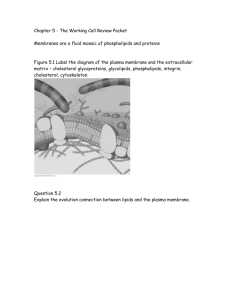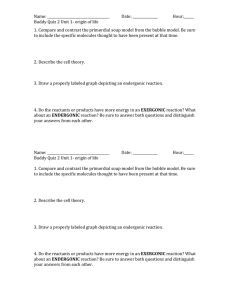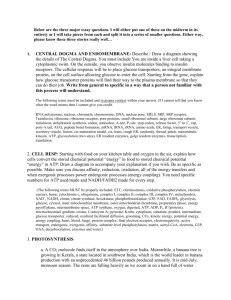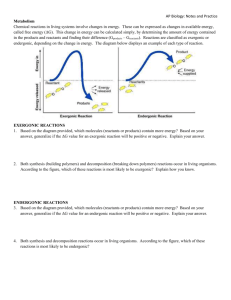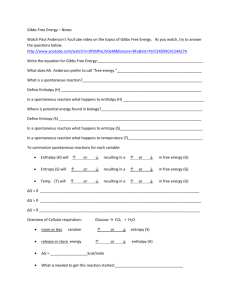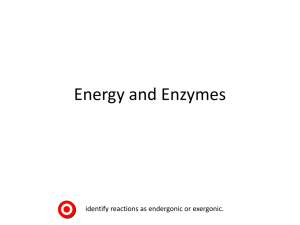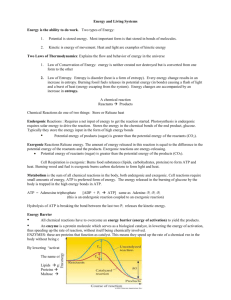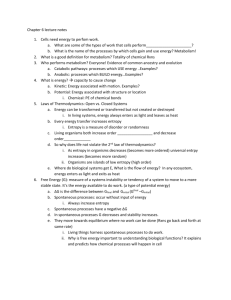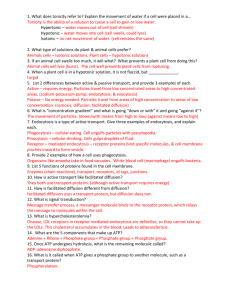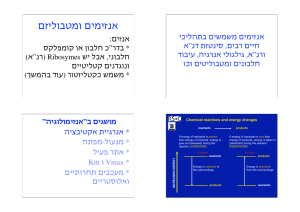Document
advertisement
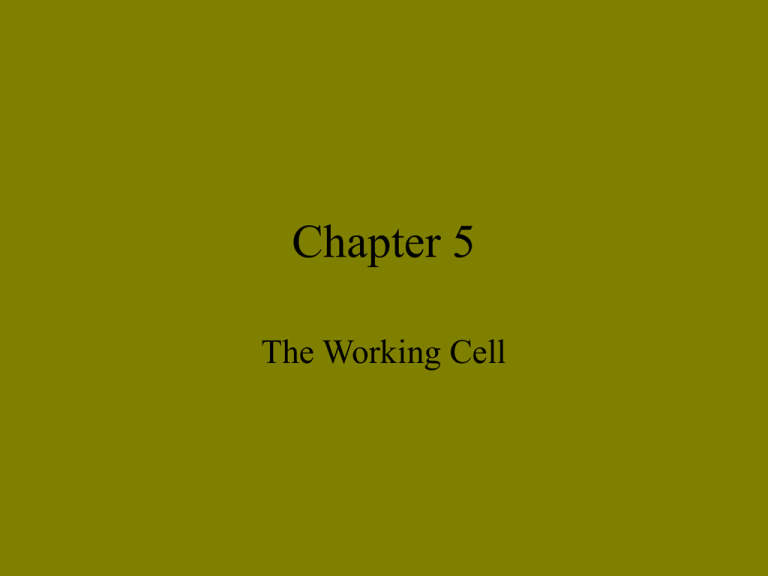
Chapter 5 The Working Cell • What do Fireflies have to do with energy? • The light flashes they create require energy • What is the main reason for producing the light flashes? • Males flash to attract females • Why is this female eating a male? • She has attracted another species and decreases competition by getting rid of it. • What type of insect is a firefly? • A beetle • What are the two components necessary for the firefly to make light? • Luciferin and the enzyme luciferase • What does luciferase need to catalyze the reaction? • Oxygen and energy from ATP • What do all cells need to have to survive? • Membranes • What is the definition of energy? • Energy is the capacity to do work • What kind of energy does pedaling a bicycle require? • Kinetic - the energy of motion • Name two kinds of kinetic energy • Light and heat • How can an object at rest have energy? • It has potential energy • What is the most important type of energy for living organisms? • Chemical energy - the potential energy of molecules • What is an energy transformation? • When energy is changed from one form to another. • Give two examples of energy transfers • Gas burns to release kinetic energy that pushes the pistons, Sugar is rearranged to form other molecules releasing energy. Potential is converted to kinetic in these examples • Explain how 217 big macs could power a car for 88 miles? • The potential energy in the bonds of the polymers of 217 Big Macs can be converted into kinetic energy • How do the two cheetah pictures illustrate energy transformation? • The cheetah has potential energy obtained from food and transfers that to kinetic energy when it runs • What is the 1st law of thermodynamics? • Energy cannot be created or destroyed • How does the pumping of gas or drinking of a soda illustrate this law? • The gas or soda will be converted into energy to power the car and the woman • What is the second law of thermodynamics? • The entropy (disorder) of the universe is increasing. • What does that mean? • Basically, no energy transformation is 100% efficient. Heat is disordered energy and increases the disorder of the universe • Animation and another Which has more potential energy in the graph, the reactants or products? The products What type of reaction has more energy in the products? Endergonic Give an example of an endergonic reaction Photosynthesis • Which has more energy in the graph, the reactants or products? • The reactants • What type of reaction has more energy in the reactants? • Exergonic • What does this mean? • It releases energy • Why does ATP break apart so easily? • Three negative P together is not very stable • What else happens when the phosphate comes off? • Energy is released • What is energy coupling? • It is when a really exergonic reaction is used along with an endergonic reaction to make the endergonic reaction happen • Explain how ATP is coupled to the movement of a protein • The phosphate comes off the ATP and temporarily stays on the protein, as the protein knocks it off it moves` • Exergonic reaction produce ______ while endergonic reactions use ____ and release ______ and ___ • ATP, ATP, ADP, P • If we couple these reactions we can give enrgy from an exergonic reaction to an endergonic reaction and make it happen • What type of reaction is illustrated by the picture? • Exergonic because the reactants have more energy than the products • What is the barrier called that prevents many exergonic reactions from happening? • Activation energy- like the push you have to give a ball to get it to start rolling down hill. • How do enzymes catalyze reactions? • They lower the activation energy- they grab onto the reactants and make them react. How enzymes work • What is the reactant in this reaction? • Sucrose • What are the products? • Glucose and fructose • What process did this enzyme catalyze? • The hydrolysis of sucrose sucrase • What are two ways an enzyme can be stopped? • Something that looks like the substrate (reactant) or something that binds to another spot and changes its shape so it cannot bind its substrate Stopping enzymes Competitive inhibition Noncompetitive • What are the main components of the cell membrane? • Phospholipids and proteins • What is so special about a phospholipid? • They have hydrophobic tails and hydrophilic heads. • Two layers of phospholipids end to end are called? • A bilayer • What kind of things would be repelled by the bilayer? • Anything that is charged or hydrophilic because it can’t get through the hydrophobic tails • What is the purpose of a carbohydrate on the surface of the membrane? • They act as markers or recognition factors like A,B or O blood type • What does cholesterol do for the membrane? • Allows for space in between the tails making it more fluid membrane fluidity • Define diffusion • The tendency for particles to move from high concentration to lower concentration • What is the difference between diffusion and passive transport? • Passive is diffusion across a membrane and can include facilitated difussion • What is osmosis? • Diffusion of water across a membrane • What is hypertonic? • High solute low water • What is hypotonic? • Low solute, high water • What happens when you put an animal or plant cell in a hypotonic solution? • The animal cell will swell and burst, the plant cell actually becomes turgid • What happens to cells in a hypertonic solution? • They lose water and shrivel • What do you think flaccid means? • Limp • What process is going on when a transport protein helps move a substance along its concentration gradient? • Facilitated diffusion • Is this active or passive transport? • Passive because it does not require energy • What type of transport requires energy and moves a particle against its gradient (low to high)? • Active transport • What is it called when a cell releases particles to the outside? • Exocytosis • What is the process called when a cell takes in particles? • Endocytosis • What are the 3 types of endocytosis and how are they different? • Phagocytosis - cell eating • Pinocytosis - cell drinking • Receptor - mediated - the material binds to a receptor and is then brought into the cell- very specific • The picture on the right shows cholesterol getting into the membrane by what process? • Receptor mediated endocytosis
